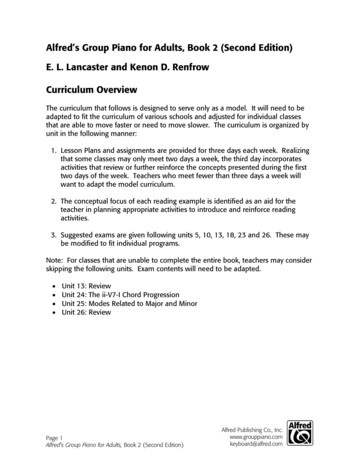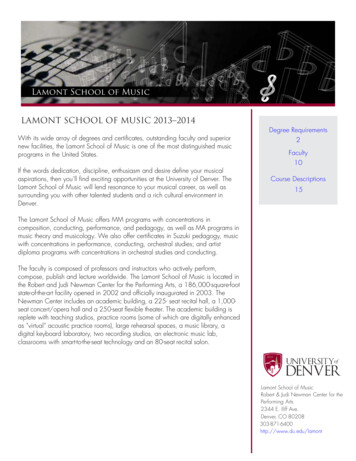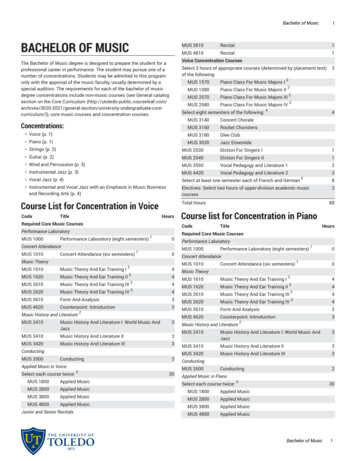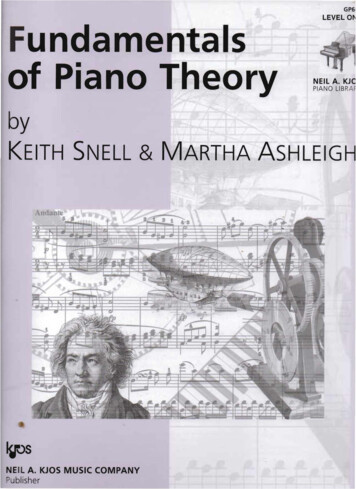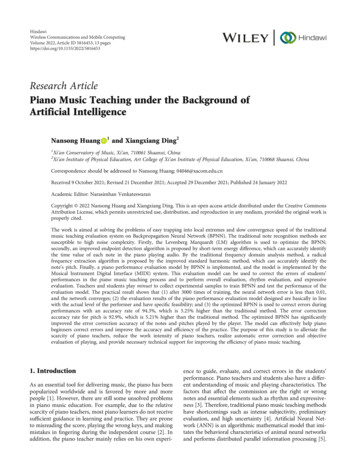
Transcription
HindawiWireless Communications and Mobile ComputingVolume 2022, Article ID 5816453, 13 pageshttps://doi.org/10.1155/2022/5816453Research ArticlePiano Music Teaching under the Background ofArtificial IntelligenceNansong Huang121and Xiangxiang Ding2Xi’an Conservatory of Music, Xi’an, 710061 Shaanxi, ChinaXi’an Institute of Physical Education, Art College of Xi’an Institute of Physical Education, Xi’an, 710068 Shaanxi, ChinaCorrespondence should be addressed to Nansong Huang; 04046@xacom.edu.cnReceived 9 October 2021; Revised 21 December 2021; Accepted 29 December 2021; Published 24 January 2022Academic Editor: Narasimhan VenkateswaranCopyright 2022 Nansong Huang and Xiangxiang Ding. This is an open access article distributed under the Creative CommonsAttribution License, which permits unrestricted use, distribution, and reproduction in any medium, provided the original work isproperly cited.The work is aimed at solving the problems of easy trapping into local extremes and slow convergence speed of the traditionalmusic teaching evaluation system on Backpropagation Neural Network (BPNN). The traditional note recognition methods aresusceptible to high noise complexity. Firstly, the Levenberg Marquardt (LM) algorithm is used to optimize the BPNN;secondly, an improved endpoint detection algorithm is proposed by short-term energy difference, which can accurately identifythe time value of each note in the piano playing audio. By the traditional frequency domain analysis method, a radicalfrequency extraction algorithm is proposed by the improved standard harmonic method, which can accurately identify thenote’s pitch. Finally, a piano performance evaluation model by BPNN is implemented, and the model is implemented by theMusical Instrument Digital Interface (MIDI) system. This evaluation model can be used to correct the errors of students’performances in the piano music teaching process and to perform overall evaluation, rhythm evaluation, and expressiveevaluation. Teachers and students play minuet to collect experimental samples to train BPNN and test the performance of theevaluation model. The practical result shows that (1) after 3000 times of training, the neural network error is less than 0.01,and the network converges; (2) the evaluation results of the piano performance evaluation model designed are basically in linewith the actual level of the performer and have specific feasibility; and (3) the optimized BPNN is used to correct errors duringperformances with an accuracy rate of 94.3%, which is 5.25% higher than the traditional method. The error correctionaccuracy rate for pitch is 92.9%, which is 5.21% higher than the traditional method. The optimized BPNN has significantlyimproved the error correction accuracy of the notes and pitches played by the player. The model can effectively help pianobeginners correct errors and improve the accuracy and efficiency of the practice. The purpose of this study is to alleviate thescarcity of piano teachers, reduce the work intensity of piano teachers, realize automatic error correction and objectiveevaluation of playing, and provide necessary technical support for improving the efficiency of piano music teaching.1. IntroductionAs an essential tool for delivering music, the piano has beenpopularized worldwide and is favored by more and morepeople [1]. However, there are still some unsolved problemsin piano music education. For example, due to the relativescarcity of piano teachers, most piano learners do not receivesufficient guidance in learning and practice. They are proneto misreading the score, playing the wrong keys, and makingmistakes in fingering during the independent course [2]. Inaddition, the piano teacher mainly relies on his own experi-ence to guide, evaluate, and correct errors in the students’performance. Piano teachers and students also have a different understanding of music and playing characteristics. Thefactors that affect the commission are the right or wrongnotes and essential elements such as rhythm and expressiveness [3]. Therefore, traditional piano music teaching methodshave shortcomings such as intense subjectivity, preliminaryevaluation, and high uncertainty [4]. Artificial Neural Network (ANN) is an algorithmic mathematical model that imitates the behavioral characteristics of animal neural networksand performs distributed parallel information processing [5].
2Among them, Backpropagation Neural Network (BPNN) isone of the more mature and widely used ANNs, and it hasan excellent performance in data classification, prediction,and related evaluation [6].Fei used BPNN to establish an evaluation model. Thevocal evaluation system uses input to solve the problem thatvocal players are greatly affected by subjective factors whenscoring. MATLAB analyzes and processes the collected dataand compares the results with personal evaluation methods.Simulation results show that this scheme significantlyimproves music classification and recognition accuracy androbustness. The system can reflect the player’s true level[7]. Jia proposed to use BPNN to simulate the nonlinearmapping of various factors and establish a vocal music evaluation system to address the problem of multiple factors andsubjective factors in the evaluation of vocal music teaching.Meanwhile, with the vocal music teaching evaluation systemas input, BPNN establishes a teaching quality evaluationmodel. The model’s validity has been verified through simulation experiments [8]. BPNN is introduced into the evaluation system, which can effectively avoid the influence ofhuman subjective factors, make the evaluation results moreobjective and accurate, and help improve students’ comprehensive ability.Traditional BPNN has defects such as ease to fall intolocal extremum and slow convergence speed [9]. It is necessary to use appropriate methods to optimize it. The premise of piano performance evaluation is the recognition ofthe played notes. Traditional musical note recognitionmethods are mainly divided into the time and frequencydomains; traditional time-domain analysis methods aresusceptible to noise. The frequency-domain analysismethod has disadvantages such as high algorithm complexity and extensive calculation [10]. Based on the aboveproblems, the Levenberg Marquardt (LM) algorithm usesto optimize BPNN. Secondly, an improved endpoint detection algorithm is proposed by short-term energy difference, which can accurately identify the time value ofeach note in the piano playing audio. A radical frequencyextraction algorithm by the improved standard harmonicmethod is put forward, which can accurately identify thenote’s pitch. Finally, a piano performance evaluationmodel by BPNN is implemented. The model is realizedmainly by the Musical Instrument Digital Interface (MIDI)system. This system can assign a value to each note in thescore, convert it into a MIDI standard signal, and store itas a MIDI file. The operation process of the performanceevaluation model is to identify the time value and pitchof each note played by the performer using improved timedomain and frequency domain algorithms. The corresponding MIDI standard file compares time values andpitch information read. Errors in playing are pointed outto realize the error correction function. This detectionalgorithm can perform overall evaluation, rhythm evaluation, and expressiveness evaluation of the performerthrough the comparison results. The study is aimed atrealizing automatic error correction and objective assessment of playing and providing necessary technical supportfor improving the efficiency of piano music teaching.Wireless Communications and Mobile Computing2. Materials and Methods2.1. Introduction to BPNN and Its Optimization2.1.1. Introduction to BPNN. The BP neural network(BPNN) is a typical representative of ANN, and it is alsothe most widely used ANN [11]. BPNN is produced by simulating the structure of the human brain neuron network,which is a complex network composed of many nodes connected [12]. BPNN is a multilayer perceptron structure thatmainly contains a three-layer structure of input, hidden, andoutput [13]. The three-layer BPNN structure is shown inFigure 1.The input layer and output layer mainly store andtransmit external information. All networks contain aninput layer and an output layer. The main difference liesin the number of hidden layers in the middle. The hiddenlayer does not directly communicate with the outsideworld, but its change will directly impact the relationshipbetween the input layer and the output layer [14]. TheBP algorithm includes two signal forward and backwardpropagation processes in the learning process. The forwardpropagation is from the input layer to the output layer. Ifthe actual and expected output signals are too far apart, itneeds to enter the reverse transmission process [15]. Backpropagation is to pass the output error back layer by layerin the direction of the input layer through the hiddenlayer, distribute it to all units in each layer, and adjustthe weight of each unit by the error signal obtained byeach layer. Then, change the connection strength andthreshold among the input layer, the output layer, andthe hidden layer so that the error can be graduallyreduced. Repeat the previous process and the learning willbe terminated until the error tends to the allowable rangeor reaches the preset practice frequency [16].In short, the BP algorithm can transform signal inputand output problems into nonlinear optimization problems [17]. BPNN has simple learning rules and a solidnonlinear fitting ability. The trained neural network canalso give appropriate output for the input near samplesnot in the sample set. The BP algorithm includes two signal forward and backward propagation processes in thelearning process.(1) Forward Transmission. The forward propagation is carried out from the input to the hidden layer and then tothe output layer. The input αi of the ith node in the hidden layer can be expressed asmαi wij x j θi ,j 1, 2, 3, , m,ð1Þj 1where x j is the input of the jth node of the input layer, wijis the weight between the ith node in the hidden layer andthe jth node in the input layer, and θi is the threshold ofthe ith node in the hidden layer.
Wireless Communications and Mobile Computing3output layer, and hidden layer are adjusted so that theerror can be gradually reduced. This process is repeateduntil the error is within the allowable range or reachesthe preset practice frequency. The learning will be terminated [18]. The quadratic error criterion function Ep ofeach sample p can be expressed asInput layerEp 1 l ðT y Þ2 ,2 k 1 k kð5ÞHidden layerwhere T k represents the expected output and yk representsthe actual output.The model’s total error criterion function for P trainingsamples can be expressed asE Output layerFigure 1: Three-layer BPNN structure.The output βi of the ith node in the hidden layer can beexpressed as!mβi ϕðαi Þ ϕ wij x j θi ,ð2Þj 1where ϕðαi Þ represents the activation function of the hiddenlayer.The input of the kth node in the output layer δk can beexpressed asqq!mδk wki βi ak wki ϕ wij x j θii 1i 1 ak ,i 1, 2, 3, , q,qyk ψðδk Þ ψ wki βi aki 1!qm ψ wki ϕ wij x j θii 1!Δwki η E, wkiΔak η E, akΔwij η E, wijΔθi η E, θið3Þ! ak ,ð4Þj 1where ψðδk Þ represents the excitation function of the outputlayer. If the error between the actual and expected outputsignals is too large, it needs to enter the backpropagationprocess.(2) Backpropagation. Backpropagation is to pass the outputerror back layer by layer in the direction of the input layerthrough the hidden layer and distribute it to all units ineach layer and adjust the weight of each team based onthe error signal obtained by each layer. Meanwhile, theconnection strength and threshold between the input layer,ð6ÞAccording to the error gradient descent method, theweights and thresholds of the output layer and the hiddenlayer are sequentially modified. The weight correction ofthe output layer is Δwki , and the threshold correction is Δak ; the weight correction of the hidden layer is Δwij , andthe threshold correction is Δθi , as shown inj 1where wki represents the weight between the kth node in theoutput layer and the ith node in the input layer and ak represents the threshold of the kth node in the output layer.The output yk of the kth node of the output layer can beexpressed as 21 P l P T yPk :2 P 1 k 1 kð7Þwhere η represents the learning rate, as shown inP l Δwki η T Pk yPk · ψðδk Þ · βi ,P 1 k 1l Δak η T Pk yPk · ψðδk Þ,PP 1 k 1P l Δwij η T Pk yPk · ψðδk Þ · wki · ϕðαi Þ · x j ,P 1 k 1P l Δθi η T Pk yPk · ψðδk Þ · wki · ϕðαi Þ:P 1 k 1ð8ÞTo improve accuracy, reduce network errors, and avoidthe phenomenon of “overfitting,” the network architectureusually only contains an input layer, an output layer, and a
4Wireless Communications and Mobile Computinghidden layer [19], and the number of nodes is generally definite in the input layer and output layer. Therefore, the number of nodes needs to be determined in the hidden layer. Theavailable number of hidden layer nodes is used to determine,as shown inpffiffiffiffiffiffiffiffiffiffiy a b c,ð9Þwhere y represents the number of hidden layer nodes, a represents the number of input layer nodes, b represents thenumber of output layer nodes, and c represents a constantbetween 1 and 10.2.1.2. LM Optimization Algorithm. Traditional BPNN hasdefects such as easy to fall into local extreme value and slowconvergence speed. The LM algorithm is chosen to optimizethe BPNN. The LM algorithm obtains the extreme importance of the function through iteration, which is the productof the combination of the Gauss-Newton iteration methodand the gradient descent method. It combines the former’slocal convergence and the latter’s global characteristics[20]. Generally, the gradient descent method drops fasterat the beginning. As the target approaches the optimal value,the gradient tends to zero, making the decline of the objective function slower. The Gauss-Newton iteration methodcan produce an ideal search direction near the optimal value.Therefore, the LM algorithm is used to optimize BPNN. Itcan solve the problem that it is easy to fall into extreme localimportance, effectively reducing the computational complexity, reducing the number of network iterations, andspeeding up the convergence speed.xk and xk 1 are two points in the function f ðxÞ, and therelationship is shown inxk 1 xk Δx:ð10ÞNewton’s method is shown in 1Δx 2 EðxÞ EðxÞ,ð11Þwhere EðxÞ is the error-index function, 2 EðxÞ is theHessian matrix of EðxÞ, and EðxÞ is the gradient. EðxÞcan be expressed asE ðx Þ 1 2e ðx Þ,2ð12Þwhere eðxÞ represents the error, as shown in Equation (13): EðxÞ J T ðxÞeðxÞ,ð13Þwhere SðxÞ represents the Jacobian ðJÞ matrix, as shown in2 e1ðxÞ6 x616J ðxÞ 66 64 enðxÞ x1 e1ðxÞ x2 e1ðxÞ xn enðxÞ x2 3777 77:7 enðxÞ 5 xnð16ÞThe calculation method of the Gauss-Newton iterationmethod is shown in 1Δx J T ðxÞ J ðxÞ J ðxÞeðxÞ:ð17ÞThe improved Gauss-Newton iteration method is theLM algorithm, as shown in 1Δx J T ðxÞ J ðxÞ μI J ðxÞeðxÞ,ð18Þwhere μ represents the proportionality coefficient, a constantgreater than 0, and I is the identity matrix.2.2. Analysis of Improved Endpoint Detection Algorithm bythe Short-Term Energy Difference. Endpoint detection isaimed at finding the start and endpoints of the musical tonesignal in a segment of the audio signal to obtain the characteristic of the length of each note in the audio [21]. Audio isinevitably mixed with noise during the recording process.The core of the endpoint detection algorithm is to accuratelyidentify the beginning and end of the music segment fromthe background noise [22]. At present, the most commonlyused endpoint detection algorithm is the double-thresholdmethod by signal time-domain characteristic parameters. Itmainly finds endpoints by setting three thresholds andadopting a secondary decision. However, the dualthreshold detection algorithm has shortcomings such asexcessive reliance on threshold setting, difficulty in thresholdsetting, and poor noise resistance [23]. This study proposesan improved endpoint detection algorithm by short-termenergy difference by the above problems.This algorithm mainly uses the short-term energy difference to find the energy mutation information to determinethe starting point of the note. Then, according to the startingpoint position, the end position corresponding to each starting point is determined by designing two layers of judgment.Regarding each note pressed during piano playing as ashort-term energy pulse, the audio signal needs to be framedand windowed and its short-term energy calculated, asshown inL 1E i j x ðn Þ j 2 :ð19ÞN 0 2 E ðx Þ J T ð x Þ e ð x Þ S ð x Þ ,ð14ÞSðxÞ ei ðxÞ 2 ei ðxÞ,ð15ÞIn Equation (19), xðnÞ is the amplitude of the nth pointin the ith frame signal and L is window length; the value isrelated to the sampling frequency.
Wireless Communications and Mobile Computing5StartMake the end point thefirst 10 frames of thenext starting pointFraming andadd windowNODetermines analternative startingpoint for the noteCalculate shorttime energydifferenceFind the end pointcorresponding toeach starting pointBefore the nextstarting point?NOYESYESAll end points searchcomplete?Is the difference between the start and end pointsgreater than the shortest tone length?YESEndNODelete the start and endpointFigure 2: Architecture diagram of improved endpoint detection algorithm by the short-term energy difference.Then calculate the short-term energy difference ΔEibetween two adjacent frames, as shown inΔEi Ei Ei 1 :ð20ÞThis algorithm is not to calculate the energy differencebetween two sampling points but to calculate the energy difference between two frames to filter out the small energyfluctuations in the audio signal. Meanwhile, the differenceoperation can better reflect the sudden change of energy,and it is easier to judge the starting position of the note.Finding the endpoint corresponding to the starting pointof each message is mainly by setting two thresholds, shortterm energy and short-term zero-crossing rate. When thetwo parameters of the signal are both lower than the threshold, the point is determined as the rough endpoint corresponding to the start point of the current note. Then, thisstudy makes a two-level judgment on the rough judgmentendpoint to improve the algorithm’s accuracy. The first levelof assessment is mainly for the rough end position obtainedin the previous step. If the endpoint corresponding to thecurrent start point is located after the start point of the following note, the endpoint search is wrong. The n framesbefore the start of the following message are regarded asthe endpoint corresponding to the start point, n l0. Thesecond-level judgment is for the difference between eachpair of start and endpoints. The difference between the startand endpoints is calculated for each pair. If the difference isless than the shortest duration of the note, then the pair ofstart and endpoints are judged as noise. It is deleted fromthe collection. The architecture of the improved endpointdetection algorithm by the short-term energy difference isshown in Figure 2.2.3. Analysis of Radical Frequency Extraction Algorithm bythe Improved Standard Harmonic Method. Radical fre-quency refers to the pure tone with the lowest frequency ineach musical style, and its intensity is the largest. The frequency of the fundamental tone is the radical frequency,which directly determines the pitch of the entire tone [24].Extreme frequency extraction methods mainly includetime-domain-based algorithms, frequency-domain-basedalgorithms, and statistics-based algorithms. The frequencydomain-based radical frequency extraction algorithms aremainly used here. The extraction algorithm by the frequencydomain is divided into two types: the harmonic peak methodand the confidence coefficient. Among them, the harmonicpeak method is a typical algorithm by Fast Fourier Transform (FFT), which mainly reflects the relationship betweensignal frequency and amplitude and is widely used to calculate signal spectrograms. The Fourier Transform FðxÞ of thenonperiodic continuous signal f ðtÞ is shown inF ðx Þ F ½ f ðt Þ ð f ðt Þe jωt dt:ð21ÞIn Equation (21), ω refers to frequency. The harmonicpeak method considers that the peak with the highest amplitude in the spectrogram corresponds to the fundamentalwave of the audio signal and uses its frequency value as theradical frequency value; that is, if the extreme frequencyvalue is x0 , then there isx0 F 1 ðmax ð F ðxÞÞ:ð22ÞThe harmonic peak method has the advantages of lowtime complexity and low space complexity. In practicalapplications, even in the sonic spectrum of a single pianotone, the amplitude of the radical frequency is not necessarily the highest, so the accuracy of this method is low.
6Wireless Communications and Mobile ComputingInputSet upSound signal ACalculate the first nmaximum points of g (x)As candidate fundamentalfrequencyFast fourier transformGet the spectrumfunction g (x)Limit [fmin, fmax]Calculate the confidencefunction h (xi)Output the fundamentalfrequency of the signal xFigure 3: The calculation flow chart of the improved standard harmonic method.The confidence coefficient is mainly proposed for theproblem that the peak amplitude of the harmonic is higherthan the peak value of the fundamental wave. In the confidence coefficient method, the entire wave or the nth (n 5)harmonic component has the most significant peak amplitude. Therefore, a factor of 1 to 5 can be obtained for themaximum peak frequency as a candidate radial frequency.The sum of the amplitudes of the nth harmonics of each radical candidate frequency has tremendous confidence that thesum is the largest. That is, it is the most likely extreme frequency. The confidence coefficient is shown inL ðN Þ fp,N1 N 5,NRðN Þ PðiÞ:ð23Þð24Þdefined as follows:8 min xk xk , 1 xk xk , x xxi xi θk ii :0:5,xk x i ,ð27Þxk x i :Given the candidate radical frequency interval ½ f min ,f max , the number of candidate fundamental frequencies n,and the scale parameter, firstly, the frequency spectrumfunction of the input audio is calculated to determine theradical candidate frequency. Secondly, calculate the probability that each candidate’s revolutionary frequency isextreme. Finally, the value of xi that maximizes hðxi Þ is usedas the radical frequency value of the signal. The calculationprocess of the improved standard harmonic method isshown in Figure 3.i 1In Equations (23) and (24), LðNÞ is radical candidate frequency, f p is maximum peak frequency, RðNÞ is the confidence level, PðiÞ is the amplitude of a particular harmonic,and n is the number of harmonics.The confidence coefficient solves the problem that themaximum peak amplitude component is harmonics to a certain extent. When dealing with low-frequency and highfrequency sound waves, there is still a problem of the highprobability of misjudgment, that is, low accuracy. The studyproposes an improved standard harmonic way to extract theradial frequency using the above harmonic peak method andconfidence coefficient issues. Using discrete first and secondderivatives, find the first n maximum points x1 , x2 , xn 1 , xnwith higher spectrogram peaks as candidate fundamentalfrequencies. Construct the confidence function hðxi Þ toreflect the possibility that xi is the radical frequency:nhðxi Þ gðxk Þt ðxk , xi Þ ði 1, 2, 3, , nÞ:ð25Þ(1) After performing a Fast Fourier Transform on A,take the modulus and limit its frequency range to ½f min , f max . The frequency spectrum function equation is as shown ingðxÞ j F FT ðAÞjðxϵ ½ f min , f max Þð28Þ(2) Calculate the first n maximum points x1 , x2 , xn 1 , xnof gðxÞ and use them as the radical candidatefrequency(3) Calculate the confidence function hðxi Þ of each radical candidate frequency(4) x max ðhðxi ÞÞ2.4. Construction of Piano Performance EvaluationModel by BPNNk 1In Equation (25), gðxk Þ is the energy value corresponding to the candidate radical frequency xk and tðxk , xi Þ isthe closeness of xk to an integer multiple of xi . It is defined as212t ðxk , xi Þ pffiffiffiffiffiffi e ðθk Þ /2σ ðk 1, 2, 3, , nÞ:2πσð26ÞIn Equation (26), σ is the scale parameter and θk is2.4.1. Music Performance by MIDI Standards. MIDI is astandard for electronic music. When a player uses a MIDIinstrument to play, the MIDI instrument will convert theplayer’s operations into MIDI signals and then pass theseMIDI signals to the sequencer. A sequencer is a device thatorganizes, edits, and outputs the timbre, rhythm, notes,etc., required by a piece of music to the sound source forsound production. The stored MIDI signal is a MIDI file[25]. After obtaining the MIDI signal, the characteristics of
Wireless Communications and Mobile ComputingImproved endpoint detection algorithm basedon short-time energy differenceAudio segmentationDrawing spectrum diagramFundamental frequency extraction algorithmbased on improved normal harmonic methodRead standard informationfrom MIDI filesCompare standard informationwith identification resultsCompleteFigure 4: Flow chart of error correction for piano playing music byMIDI files.the sound can be analyzed, such as time value and pitch. In aMIDI system composed of a personal computer, the MIDIinput device of various MIDI musical instruments is directlyconnected to the computer sound card. A sequencer is computer software that acquires MIDI signals obtained mainlythrough the computer operating system. The ApplicationProgramming Interface (API) is obtained from the computer sound card. The MIDI messages received by the computer system are composed of multiple bytes [26].2.4.2. Error Correction of Piano Playing Music by MIDI Files.After obtaining a piece of piano playing audio, first, get eachnote’s start and endpoints through the improved endpointdetection algorithm by the short-term energy differencementioned above. At this time, the time value informationof the note is also determined. The report divides the original signal to obtain all the letters in the audio to obtain themovement. Second, through the radical frequency extractionalgorithm by the improved standard harmonic method,identify the pitch information of each note. Finally, the notetime value and pitch information obtained by the two stepsare compared with the corresponding standard informationin MIDI music to find out the wrong note played by theplayer. The error correction process of piano playing soundby MIDI file is shown in Figure 4.2.4.3. Confirmation of Input Parameters(1) Determine the Parameters of the Pitch Feature. JohannSebastian Bach’s minuet is an example of implementing apiano performance evaluation model. There are five notesin the first bar of this piano music. The high notes are D,G, A, B, and C. MIDI messages are 74, 77, 70, 71, and 72.The input parameter is 5/5 1 when playing five tones, 4/5 0:8 when playing four styles, and so on. The total score7has 48 bars, so the input parameters of the high pitch featurerequire 48 neurons in the input layer.(2) Determine the Parameters of Rhythm Characteristics.Rhythm is a feature that describes the length of the sound,and the time represented by the score is relative. It needsto be converted to absolute time to get the differencebetween the length of the sound [27]. Take the first measureof minuet as an example. The first note is a quarter note witha duration of 1, and the last four notes are all eighth noteswith a period of 0.5. Suppose each note pronunciation’s totaltime is 0 s and 0.75 s, and the duration is 0.75 s and 0.25 s,respectively. If the sounding time of the note is 0.1 s and0.8 s and the course is 0.7 s and 0.3 s, respectively, theplayer’s sense of rhythm can be calculated byf ðxÞ absðSi Bi ÞQi absðEi Di ÞQi :ð29ÞIn Equation (29), Si is the sounding time or duration ofquarter notes when playing, Bi is the absolute time or thehypothetical quarter note pronunciation, Ei is the pronunciation time or duration of the eighth note when playing, Di isthe absolute time or duration of the hypothetical eighth notepronunciation, and Qi is weight.According to Equation (29), the player’s sense of rhythmis shown inabs ð0:1 0Þ abs ð0:8 0:75Þ 0:15,abs ð0:7 0:75Þ abs ð0:3 0:25Þ 0:1:ð30ÞSince the duration has little influence on the performance effect, multiplying by the weight of 0.1, the rhythminput parameter is 0:15 0:1 0:1 0:16. The input parameters of the rhythm also require 48 neurons in the inputlayer.(3) Determine the Parameters of the Beat Feature. The beat isa feature that describes the strength of the sound. The scorehas a minimal representation of the power of the sound, andthe term of the force is a relative value [28]. Artificially judgethe average value of input samples with excellent beat control as the MIDI standard signal. The beats of the secondbar of the piano score of minuet are strong, weak, and weak.Let the traditional values of the strength of each note be 100,70, and 80, respectively, and the values obtained by the performer are 95, 75, and 70, respectively. The beat inputparameter in this section is 5 5 10 20. The inputparameters of the beat require 48 neurons in the input layer.(4) Determine the Parameters of the Chord Characteristics.Chords are composed of simultaneous pronunciation at atime point [29]. The time point of each chord can beobtained in advance from the music score and standardMIDI files. The chord judgment is performed on each chordtime point during the playing process. The difference inpitch is used to judge whether the fundamental tone is rightor wrong. The number of chord judgment errors is 1, and if
8Wireless Communications and Mobile ComputingComputerThe structure of the piano performance evaluationmodel by BPNN designed is shown in Figure 5.Main pageLoa
Oct 09, 2021 · essary to use appropriate methods to optimize it. The pre-mise of piano performance evaluation is the recognition of the played notes. Traditional musical note recognition methods are mainly divided into the time and frequency domains; traditional time-domain analysis methods





